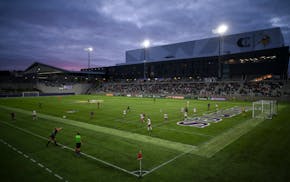Minnesota is known for its exquisite stadiums that are rich with a community's history. Venues offer their own uniqueness, which lie in the eye of the beholder.
Baseball and softball were invented to be played on dirt infields and plush green grass, albeit not always conducive to Minnesota weather. Artificial turf surfaces don't compare to a well-groomed infield and freshly cut outfield with various designs in the grass.
Here are some of the state's most renowned facilities, in alphabetical order, fans of the sport should check out. It will be worth the excursion.
Baseball
Athletic Park (725 W. 1st St., Chaska)
Opened in 1951, the classic mid-20th century looking stadium has survived the test of time. The wooden seats under the covered grandstand, cinder block dugouts, and well-maintained field is located between the Minnesota River and sloping hills of the historic town. It's tucked away amongst large trees, providing a peaceful setting.
Cold Spring Park (700 1st St. S., Cold Spring)
The home of the Rocori Spartans is the crown jewel of the community. "Most people would say what draws them to the park is the fact that it has that old-style traditional feel to it," Spartans coach Jeff Illies said. "The community of Cold Spring maintains the field mostly through the hard work and help of volunteers." The incredible playing surface gives way to ivy-covered outfield fences, patterned after Chicago's Wrigley Field. The immaculate grass is cut in a traditional checkerboard pattern. "The park is and has been one of the top baseball stadiums in Minnesota year in and year out," Illies said.
Johnson Park (500 N. German St., New Ulm)
This diamond leaves players wishing every park could be this pristine. What the park lacks in ambience is more than made up in its immaculate-looking turf and smoothness of the infield dirt. You can't say "it took a bad hop" in one of the town's two outstanding diamonds.
Memorial Park (214 S. 1st St., Dundas)
An outstanding facility plays host to the Northfield Raiders. It sits along the Cannon River in a historic mill town. Lush, fully grown trees surround the facility. Two $100,000 renovations over the last 10 years have taken the park to another level. The main grandstand has been updated, moving fans 12 feet closer to home plate while more than 100 stadium chairs have been added. The three-flower gardens are also a lovely touch.
Mini Met (401 Rice St. S., Jordan)
Home of the Hubmen and state tournament matchups presents plenty of uniqueness. Built on the old Scott County fairgrounds, the diamond is surrounded by trees. A fan can sit in the covered stands behind home plate that extend toward third base, the metal bleachers behind first base, the patio down the left-field line or relax in the grassy knoll beyond third base. There are a couple of nooks and crannies in the outfield due to light stanchions. Those can result in odd caroms, resulting in extra bases for hitters. The well-groomed field and nostalgic atmosphere will periodically give way to the blowing horn of a passing train behind the left-field wall.
Municipal Park (559 River St. N., Delano)
This well-manicured field also boasts an ivy-laced covered outfield fence. What separates this venue from others is the variety of locations where you can watch the game, whether it's the shade-covered stands behind home plate, the four-tiered baseline decks, right and left field viewing decks or the high tables and bench seats. The infield features DuraEdge dirt, the only high school field so far that uses the same product as Target Field and St. Paul's CHS Field. The tall pine trees that line the outfield give the ballpark a perfect ambiance. "When it comes to a total fan experience, the 'Muni' leaves no stone left unturned," Delano coach Toby Hanson said. "It's not just a place for ballgames, it's a place to put on a show."
Parade Stadium (400 Kenwood Pkwy., Mpls)
The field adjacent to the Minneapolis Sculpture Center and Walker Art Center isn't used as much on the prep level as it once was. The bleachers slapped around the backstop offer views of the Basilica of St. Mary and the city's skyline that is illuminated at dusk. The view offsets the basic ballpark look. Just be careful where you park. An additional souvenir could be waiting.
Riverside Park (2 E. Central St., Springfield)
It takes a blast to hit a dinger to straightaway centerfield, a mere 452 feet from home plate. And that isn't even the deepest part of the field (470 feet) due to the football field still being in use. The rich 118-year history of the park located along the Cottonwood River has taken on a more modern look with recent improvements — in-ground dugouts with a picnic area above third base and a plaza on the first base side. Local bricks were used for the fence behind home plate and walls that run from the first base dugout to the third base dugout.
Storm Stadium (2200 Lyman Blvd., Chanhassen)
One of the newer stadiums, built in 2010 after the high school was opened, gleams at night under the lights. The classic wrap-around wooden grandstand has plenty of seating between the first and third base dugouts, with one separate row of bleachers right up against the screen. It's a picturesque facility.
Tiger Park (201 S. Eagle St., Belle Plaine)
Another venue where it takes an absolute bomb to get it over the 435-foot centerfield wall. This park gives fans a chance to enjoy baseball history that dates back to 1885. There are three flag poles situated inside the centerfield wall. Tiger is another park where there is no curvature in the two ivy-covered outfield fences, which run parallel to the streets immediately behind them. The covered grandstand behind home plate includes steel bleachers.
Five other stadiums worth venturing to: Bell Field in Faribault; Irish Yard in Milroy; Marthaler Field in Glenwood; Tink Larson Field in Waseca; and Veterans Field in Minnetonka.
Softball
Fastpitch softball at the high school level doesn't have baseball's deep history and tradition. Softball fields tend to be similar and orderly, with few varying features to add nostalgic charm.
The reason for static nature of softball fields is largely a result of dimension. The game itself is played on a field smaller than that of baseball, which doesn't allow for uniqueness. Baselines are 60-feet long rather than 90 for baseball, which precludes the use of grass infields that slow the ball down. There is no mound as a visual centerpiece as the pitching rubber is just 43 feet away.
Softballs don't fly as far as baseballs when hit, which means outfield fences are frequently temporary, erected to a specific dimension rather than contoured to the available space.
As such, unlike baseball, it's rare to find a softball field that is a destination unto itself. Softball fields are often memorable for its amenities or its history.
Because softball fields tend toward uniformity, staff writer Jim Paulsen asked a few notable high school softball coaches to identify their favorite diamonds.
(Editors note: Answers edited for length and brevity)
Bryan Woodley, Champlin Park: "We were able to play at LeSueur-Henderson a couple of years ago. I thought this was a great venue. You could feel the tradition in the old school charm. Brainerd is a unique field down in the bowl and you have to walk through the large baseball stadium to get to the softball field surrounded by wetlands. I think Rice Creek [Shoreview] is one of the best fastpitch facilities around. I don't think you could find a better fastpitch complex in the state. Elk River's new fastpitch stadium is amazing"
Angie Ryan, Stillwater: "The new Elk River varsity facility is really nice. They have concessions and bathrooms on site as well and high quality bleachers, etc. We play at the University of Northwestern [in Roseville] for our section tournament and that's really nice. The bathrooms are heated and it's beautiful. Park of Cottage Grove's new Charlie Whitbred Field is nice. East Ridge, with it being a new high school, is pretty nice. They have storage attached to the dugouts. Caswell Field [in Mankato] is obviously really nice. Rice Creek Fields is one of, if not the best, pinwheel tournament facilities in the metro. I'm excited the state championship games have been moved to Jane Sage Cowles Field [at University of Minnesota]."
Paul Harrington, Farmington: "The grandstand at Chanhassen is awesome and the best around for fans. The U of M finally hosts the four championship games. It was a long battle to make that happen, but was glad to be a part of it."
Jim Koltes, Maple Grove: "[Softball fields at] Mankato East, Forest Lake, Eagan, Elk River (very new and nice), Delano, Rosemount, Richfield."

Minnesota Aurora still wants to go pro, but has the NWSL priced them out?

Scoggins: To win a title, the Wolves have the three most important pieces
Paige Bueckers steps into the WNBA spotlight tonight vs. the Lynx
Byron Buxton, Carlos Correa injured in collision during Twins' 11th consecutive victory

